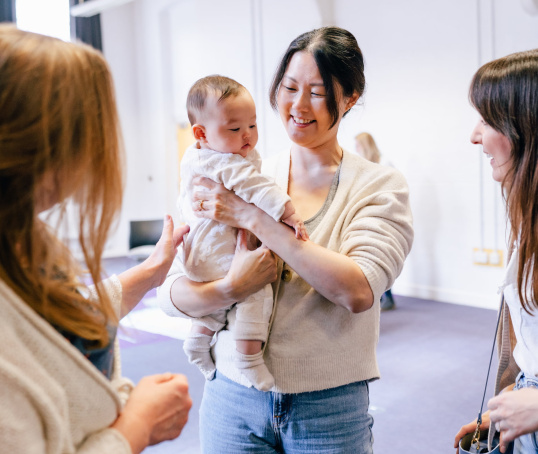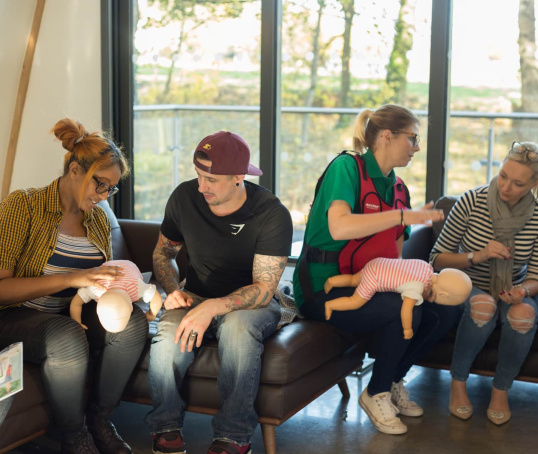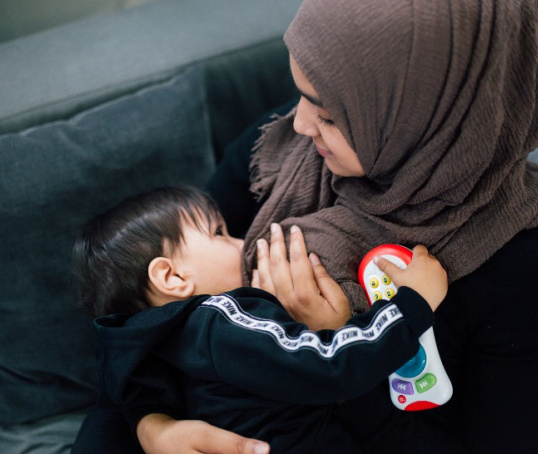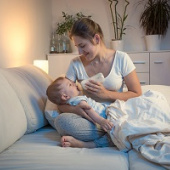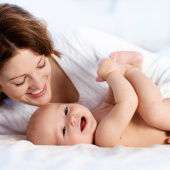It can be hard to know what the best sterilising method for your baby’s feeding equipment is and how to do it. Here's some information to help.
Why do I need to sterilise my baby’s feeding equipment?
A baby’s immune system is not as well developed as an adult’s. So they could become very ill if they drank milk that was contaminated with bacteria.
Milk provides an ideal breeding ground for bacteria that could cause food poisoning, but sterilising kills the majority of these bacteria. Sterilising all your baby’s feeding equipment helps to protect your baby against these illnesses, in particular diarrhoea and vomiting (First Steps Nutrition Trust, 2021).
That’s why, in the UK, the NHS recommends that all equipment used for collecting, storing or feeding expressed breastmilk or formula milk for babies under 12 months is sterilised before use (NHS, 2019a).
How long do I need to sterilise bottles and other feeding equipment for?
The NHS recommends sterilising all feeding equipment each time you use it for at least the first 12 months of your baby’s life (NHS, 2019a). Washing items in a dishwasher doesn’t have the same effect of killing the bacteria (NHS, 2019a; 2021).
Do I still need to wash feeding equipment before sterilising it?
Yes, it’s still important to wash your baby’s feeding equipment thoroughly to remove any dried-on milk, because bacteria can grow on any remaining milk. As soon as possible after you’ve used bottles, teats, breast pumps and any other milk collection, storage or feeding equipment, thoroughly wash them in warm, soapy water. Check they are not damaged, too (NHS, 2021).
If you’re using a dishwasher, make sure you place bottles and teats face down, so they don’t fill with dirty water. If you're washing by hand, using clean bottle and teat brushes will help you reach every part of the bottle, teat or breast pump. Only use these brushes for cleaning your baby’s bottles and teats (NHS, 2019a).
After washing, rinse all equipment in clean, cold, running water before you sterilise it (NHS, 2021).
Which method of baby bottle sterilisation is best?
We can’t say for sure which method of sterilisation is more effective than another. So you might want to consider what suits you best to help you decide which method to use.
Cold water sterilising
Cold water sterilisers use chemicals, which are mixed with cold water, to sterilise feeding equipment. They can be bought in tablet or concentrated liquid form, which you add to cold water. They are also available as a ready-to-use sterilising solution.
Items you're sterilising need to be submerged in the cold water solution for at least 30 minutes before you use them (NHS, 2019a; 2021). This method can be used to sterilise a large number of items, making them ready for use as soon as you need them.
How to cold water sterilise baby-feeding equipment
- Use a clean, watertight container with a well-fitting lid.
- Make up the sterilising solution in accordance with the manufacturer’s guidelines.
- Try to make sure all items remain fully submerged in the solution and that there are no air bubbles. Items might need to be held in place by a floating cover or plate.
- Leave the items in the solution for at least the length of time specified by the manufacturer and follow the guidance on how often to change the solution.
- Remove items from the solution immediately before use. Shake off any excess solution or rinse with cooled boiled water from the kettle (not the tap).
- Make sure you have clean, dry hands before removing items from the solution.
(NHS, 2019a; 2021; Public Health Scotland, 2021)
Boiling
The majority of bacteria are killed at a temperature of 100°C (boiling point of water) for 10 minutes. You do not need any specialised equipment, so this method is particularly useful if you're only sterilising occasionally.
Boiling might be particularly useful in the very early days. For example, if you need to hand express some colostrum to feed to your baby using a small cup or teaspoon you’ve sterilised (see our article about expressing and storing your milk for more information).
If you do use this method on a regular basis, some items may be damaged by the heat so might need replacing more regularly (NHS, 2021).
How to sterilise baby-feeding equipment by boiling
- Check that the item is safe to boil.
- Bring a saucepan of water to the boil.
- Submerge the items to be sterilised in the boiling water, making sure they are completely covered and continue to boil for at least 10 minutes. You could set a timer so you don’t forget to turn the heat off.
- Never leave hot pans and liquids unattended.
- Keep the items covered and remove them just before use.
(NHS, 2019a; 2021)
Steam sterilising
This works on the same principle as boiling. Water is added to the sterilising unit and the water boils, creating steam that kills the bacteria.
Several different types of steam sterilisers are on the market. Some steam sterilisers are used in a microwave, while others are stand-alone units that plug into the mains. Some microwave steam sterilisers can also be used as cold-water sterilisers.
It is also possible to buy reusable steriliser bags for use in the microwave, or bottles that can be sterilised alone in the microwave. These might be a more convenient option when you're away from home but have access to a microwave, or if you don’t think you’ll need to sterilise equipment very often.
How to steam sterilise baby-feeding equipment
- Follow the steam steriliser manufacturer’s instructions, which normally involves adding a specific amount of water to the unit and running it for a specific period of time. The length of time can vary from one steam steriliser to another.
- Ensure the openings of bottles and teats are facing downwards in the steriliser.
- Again, check the manufacturer’s guidelines for information about how long you can leave items in the steriliser before using them.
(NHS, 2019a; 2021)
What to do after sterilising
- You can leave sterilised items in the steriliser or pan until you need them but the majority of manufacturers advise using or re-sterilising after 24 hours. If you do take sterilised items out, you’ll need to put the teats and lids on the bottles immediately.
- Clean and disinfect the area that you’ll be using to prepare the feed or assemble the pump, or use the upturned lid of the steriliser.
- Wash and dry your hands before handling sterilised equipment. Better still, use some sterile tongs.
(NHS, 2019a)
Expressed breastmilk
Breastmilk contains ingredients that limit the growth of unwanted bacteria, but you’ll still need to store and handle it carefully to prevent unwanted bacteria contaminating the milk. See our articles Expressing milk using a breast pump and Expressed Milk: Your questions answered.
You’ll need to thoroughly wash and sterilise the cup, bottle or spoon and the washable parts of the breast pump just before you use them again (NHS, 2019b).
Formula milk
Powdered infant milks are not sterile, so it’s important that they’re made up in line with the instructions on the packet (NHS, 2019c). This will get rid of most of the micro-organisms that may be present (First Steps Nutrition Trust, 2021). Ready-made liquid formula milk is sterile until it is opened, but all feeding equipment will still need to be sterilised (NHS, 2021). See our articles Step-by-step guide to preparing a formula feed and What if I need to formula feed my baby away from home?
Any formula milk that’s left in the cup or bottle at the end of the feed should be thrown away (NHS, 2019c). And you’ll need to thoroughly wash up and sterilise the cup, bottle or spoon just before you use them again (NHS, 2019a).
Sterilising when out and about
Going out for the day or going on holiday can make the practicalities of sterilising, storing expressed breastmilk, or making up formula more challenging. So if you’d like to talk through how to do this when away from home, you can speak to one of our Breastfeeding Counsellors by calling our Infant Feeding support Line (see below).
Sterilising and microplastics
It has been reported that heating plastics frequently to the high temperatures needed for sterilisation by boiling or steaming them, then shaking when making up formula, releases microplastics from the bottles. The effect of these microplastics on humans is currently unknown (Li, 2020).
UNICEF have recommended parents follow current NHS guidelines until further research investigates the effect of these microplastics (IHV, 2020). Some parents prefer to use glass bottles to avoid microplastic contamination.
Where can I go for support?
You can speak to one of our NCT Breastfeeding Counsellors about any aspect of feeding your baby by calling the NCT Infant Feeding Line on 0300 330 070. The lines are open from 8am to midnight every day.
You might also find it useful to talk things through with your midwife or health visitor (NICE, 2015).
This page was last reviewed in February 2022, updated February 2025.
Further information
NCT supports all parents, however they feed their baby. If you have questions, concerns or need support, you can speak to a breastfeeding counsellor by calling our NCT Infant Feeding Line on 0300 330 0700. Breastfeeding counsellors have had extensive training, will listen without judging or criticising and will offer relevant information and suggestions. You can also find more useful articles here.
You might find attending one of our NCT New Baby groups helpful as they give you the opportunity to explore different approaches to important parenting issues with a qualified group leader and other new parents in your area.
Make friends with other parents-to-be and new parents in your local area for support and friendship by seeing what NCT activities are happening nearby.
First Steps Nutrition Trust. (2021) Infant milks: a simple guide to infant formula, follow-on formula and other infant milks. First Steps Nutrition Trust, London. Available at: https://www.firststepsnutrition.org/parents-carers [Accessed 15th February 2022].
IHV. (2020) Unicef UK response to new research on the release of microplastics during infant formula preparation Available at: https://ihv.org.uk/news-and-views/news/unicef-uk-response-to-new-resear… [Accessed 15th February 2022]
NICE. (2015) Quality Statement 6: formula feeding.
NHS. (2019a) Sterilising bottles. Available at: https://www.nhs.uk/conditions/baby/breastfeeding-and-bottle-feeding/bot… [Accessed 15th February 2022]
NHS. (2019b) Expressing and storing breastmilk. Available at: https://www.nhs.uk/conditions/pregnancy-and-baby/expressing-storing-bre…
NHS. (2019c) How to make up baby formula. Available at: https://www.nhs.uk/conditions/baby/breastfeeding-and-bottle-feeding/bot… [Accessed 15th February 2022]
NHS. (2021) Start4Life guide to bottle feeding: How to prepare infant formula and sterilise bottles. [Accessed 15th February 2022]
Public Health Scotland. (2021) Formula feeding: How to feed your baby safely. Available at: https://www.parentingacrossscotland.org/info-for-families/resources/for… [Accessed 26th February 2022]
